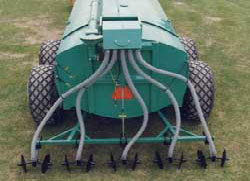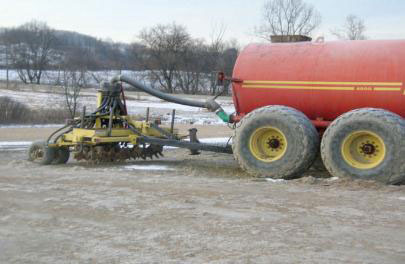Dairy Manure Spreader Types and Calibration
Introduction
Spreaders need to be able to apply manure uniformly, effectively, and consistently from load to load and over time. The proper selection and calibration of a manure spreader ensures its optimal use and functionality of the manure as a major source of crop fertility while also avoiding over application of nutrients that can lead to environmental issues. There are several spreader systems, of which all have specific calibration methods. Manure application systems generally fall into one of the following three categories:
- Solid manure systems that store, move and spread manure on soil surface.
- Liquid manure systems that apply manure to the soil surface.
- Liquid manure systems that inject manure into the soil, below the surface.
To manage manure on farms it is essential to know the quantity being spread. Knowing the amount of manure spread at the planned rate as well as plant nutrients available from the manure enables an adjustment to be made to the amount of fertilizer needed. It is important to spread the manure as evenly as possible to avoid part of the field getting excessive nutrients and another part not getting enough. Equally important is spreading the manure over the whole farm since the most of the nutrients in the manure came from the cropland. This will also avoid potential accumulation of excess nutrients in fields.
Solid Manure Systems
Solid manure is defined as manure that contains greater than 20% solids by weight. Solid manure and semi-solid manures are generally handled by tractor pulled or truck mounted box spreaders. The box spreaders vary in their capacities, ranging from two to twenty tons and manure is distributed with the help of a dispensary mechanism out the rear of the spreader. Some types of solid spreaders include, flail, side discharge and spinner spreaders. Flail spreaders are used for drier manures, and chain flails help to handle manures with varying moisture levels, by distributing it out the sides of the spreader. Side discharge spreaders have augers within the hoppers to move the manure toward a rotating panel or expeller where the manure is then distributed evenly as the tractor moves forward. Spinner spreaders have a similar design to the hopper spreaders except the spinning of disks at the rear of the auger brings about discharge of manure. Adjustments can be made by changing the disk speed or angle.
Liquid Manure Systems

Figure 1: Concave disks
Liquid manure is defined as manure that contains less than 10% solids. A tank wagon with splash plates is typically used to surface broadcast the manure. However, this method most often lends itself to non-uniform spreading, with much odor. There are several types of attachments that can be used to help improve uniformity and tanker performance. To deliver the manure slurry closer to the ground, booms can be added to the dispenser with nozzles and drop hoses, to help distribute the manure more evenly and minimize odor problems. Other types of liquid manure applicators include direct injection or immediate incorporation of manure into the soil. These types of spreaders are quickly gaining popularity in the dairy industry because they achieve greater manure use by reducing nutrient loss from volatilization, runoff, and odor. This method can work several ways. The tank truck can have adaptors such as aerators (knives), cultivators, or concave disks. Areators, such as the AerWay, cut grooves into the soil and manure is then directly injected into those grooves. Culitvators and concave disks help to incorporate manure right after application.
Calibration

Figure 2: Complete one pass spreader
system with aeration attachment
Depending on which manure spreader system is being used, varying calibration methods need to be applied to guarantee that each system is operating to its fullest potential. By calibrating, you ensure that the correct amount of nutrients is being delivered to the crops. If your spreader has not been calibrated, then chances are you are not applying nutrients effectively. Good management practices also include record keeping. Maintaining records of your calibrations and applications can help to improve the overall fertility of your farm operation and assist in trouble shooting problems.
How to Calibrate Manure Spreader:
Method 1 (solid or semi-solid manure)
Equipment required: Two to three plastic sheet 6 x 6ft or 10 x 10ft, scale, and a bucket for each sheet.
- Weigh each sheet with its bucket on the scale.
- Lay sheets in the field in the path of manure spreader, apart from one another and position them so the tractor will be at spreading speed before it reaches the sheet. Secure each sheet’s position with heavy stones or stakes.
- After spreading, weigh each sheet and manure in its respective bucket, being careful not to spill any manure. Repeat this step to get an average weight.
- Subtract weight of the empty bucket and sheet in Step 1 from the weight in Step 3. This number tells the weight of the manure on each sheet.
- To determine how much manure is applied per acre use the following formula:
- (Wt. of collected manure (lb.) x 21.8) ÷ size of sheet (sq. ft.) = Tons manure/acre
Method 2 (liquid manure)
- Equipment required: yard stick, rope.
- Determine manure spreader capacity (see factsheet number 11-35).
- Tie string around the top of the tractor tire. Mark the ground where the string falls directly below the tire. Move tractor forward until the string is back on top again. Mark the ground again, to where the string lies. Measure the distance between these two distances to determine the distance traveled by one revolution of the tire.
- Spread manure load, and count wheel revolutions. To determine the distance traveled to spread the load, multiply the number of tire revolutions it took to spread the load by the number of feet the tractor moved in one revolution.
- Measure the width of manure covered by the spreader.
- Multiply the distance traveled (Step 3) by the width of manure covered (Step 4) and divide by 43,560 (the number of square feet in one acre) to determine area (in acres) covered by one load.
- Divide spreader capacity (Step 1) by acres covered (Step 5) to determine tons or gallons applied per acre. Once the spreading rate is determined, adjustments can be made to tractor speed or spreader settings to chieve the desired rate. It is crucial however, to recalibrate the spreader after any adjustment.
Note Quick Manure Conversions
1 ton= 2000 pounds
1 cubic foot = 7.5 gallons
1 bushel = 1.25 cubic feet
1 gallon = 8.3 pounds
1 cubic foot = 62 pounds (wet) to 55 pounds (dry)*
*Manure density ( weight per cubic foot) See factsheet 11-34 for more details in calculating.
Note Recalibrate the manure spreader after any adjustment so as to ensure desired rate.
Resources
Beegle, D. 2003. Penn State Agronomy Guide. p. 39-41. Penn State University. http://extension.psu.edu/publications/agrs-026
Jokela, Bill. Manure Spreader Calibration. University of Vermont, Cooperative Extension Service. http://www.uvm.edu/pss/vtcrops/articles/ManureCalibration.pdf
Martin, Gerald. Manure Spreader Calibration.
Agronomy Facts 68. Penn State University, Cooperative Extension Service.
http://extension.psu.edu/plants/crops
For more information visit the UMass Extension Crops, Dairy, Livestock & Equine Program
Factsheets in this series were prepared by, Masoud Hashemi, Stephen Herbert, Carrie Chickering-Sears, Sarah Weis, Carlos Gradil, Steve Purdy, Mark Huyler, and Randy Prostak, in collaboration with Jacqui Carlevale.
This publication has been funded in part by the Massachusetts Department of Agricultural Resources and the Massachusetts Farm Bureau Federation, Inc.